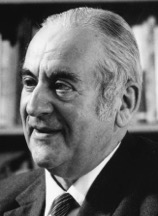
In 1941, as World War II loomed, Goudsmit took leave from Michigan to join staff working on radar at the MIT Radiation Laboratory supporting Allied military efforts. Because of his upbringing in the Netherlands, his facility with languages, and his close relationship with many European physicists, Goudsmit was recruited to become Chief of Scientific Intelligence of Alsos in 1944, the War Department’s secret mission that sent a select group of scientists, secret agents and soldiers into Europe just behind the Allied liberation forces. Their assignment was to determine Nazi Germany’s progress in developing an atomic bomb and to secure associated enemy scientists. In the book Alsos, Goudsmit’s historical memoir of that mission published in 1947, he concludes that the Nazis were not close to creating an atomic bomb.
After completing the Alsos mission in 1946, Goudsmit was briefly Professor at Northwestern University and joined the newly formed Brookhaven National Laboratory in 1948, where he was Physics Department Chairman. From 1951 to 1962 he was Managing Editor of the leading physics journal Physical Review. In 1958 he founded Physical Review Letters to provide rapid publication of emerging scientific findings and later became the first Editor‐in‐Chief of the American Physical Society. In 1974, he became Distinguished Visiting Professor at the University of Nevada in Reno, where he remained until his death.
Goudsmit also made scholarly contributions to Egyptology. The Samuel A. Goudsmit Collection of Egyptian Antiquities is at the University of Michigan's Kelsey Museum of Archaeology in Ann Arbor.
Click on the cover for details about the eBook:




